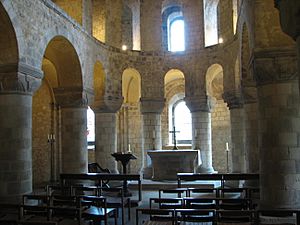St John's Chapel, London facts for kids
The Chapel of St John the Evangelist (often called St John's Chapel) is a very old Christian chapel located inside the White Tower at the Tower of London. It was built around 1080, making it one of the oldest complete chapels from the early Norman times that we can still see today. This chapel is also a special "chapel royal," which means it has a direct connection to the British royal family. A priest from a nearby church, the Church of St Peter ad Vincula, looks after it.
Building a Royal Chapel
St John's Chapel was an important part of the original design for the White Tower. This tower itself was built between 1077 and 1097 by William the Conqueror. It was meant to be a strong fortress, like a main castle or a safe place, and the chapel was right at its heart.
The chapel was built using special stone called Caen stone, which was brought all the way from France. Inside, it has a long main area called a nave with a rounded ceiling. On the sides, there are aisles with crisscross ceilings. At the very end, there's a rounded section called an apse.
The chapel's design is quite simple but strong. It has thick, round pillars that hold up plain, rounded arches. The only decorations are simple carvings of shell and leaf shapes. Later, around 1240, King Henry III added more beauty to the chapel by ordering three colorful stained glass windows to be put in.
This chapel is special because it started being built in 1080. Many other Norman churches in England were built much later, in the mid-1100s. Today, special services are still held in the chapel at different times of the year.
Important Events at the Chapel
For many years, from about 1100 to 1312, knights who were becoming part of the Knights of the Bath would come to St John's Chapel. They would take a special bath as part of a purification ceremony. Then, they would spend the night before a royal coronation (when a new king or queen is crowned) keeping watch here. The next day, these knights would escort the new monarch from the Tower of London all the way to Westminster Abbey for the coronation ceremony. Later, this ceremony likely moved to a larger church within the Tower.
In 1381, during a time of big protests called the Peasants' Revolt, a large group of people managed to get into the Tower of London. They found the Archbishop of Canterbury and the King's chief advisor, Simon Sudbury, attending a church service in the chapel. The crowd took him outside to Tower Hill.


